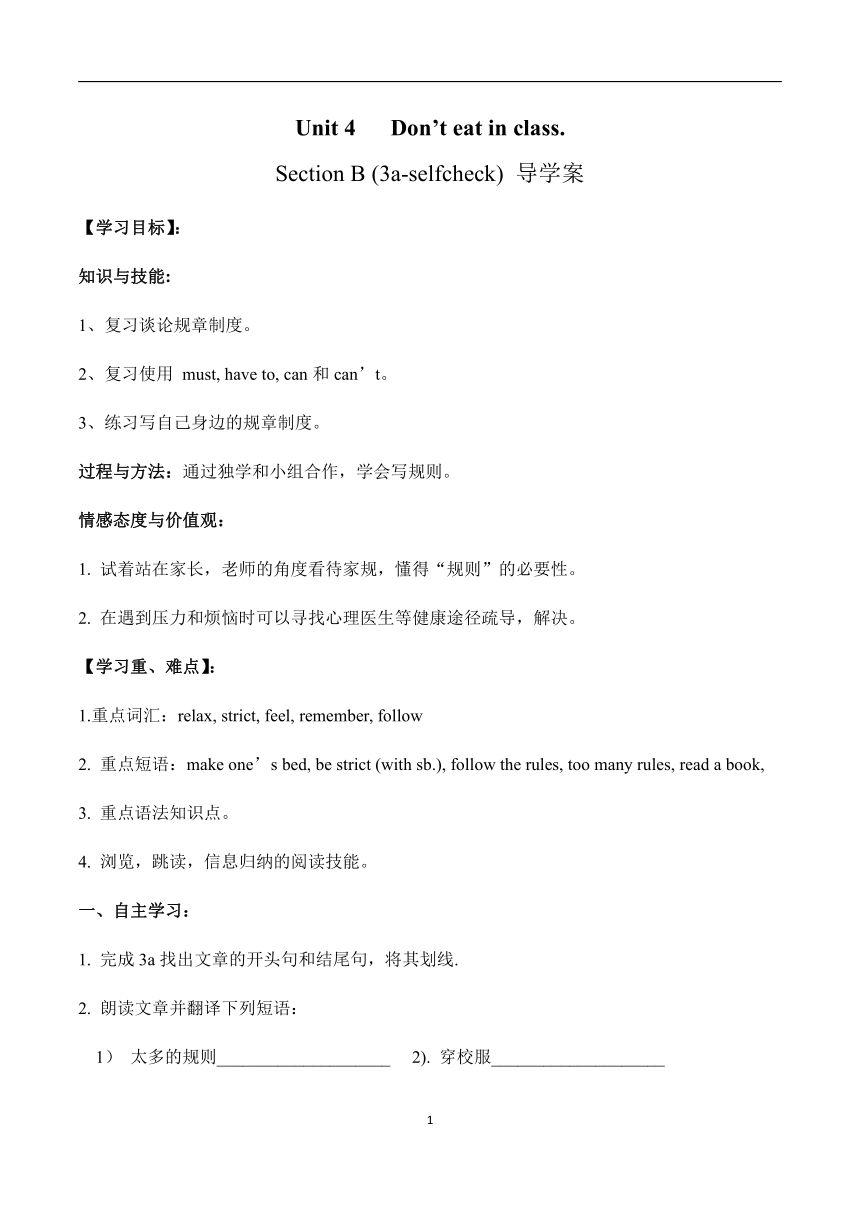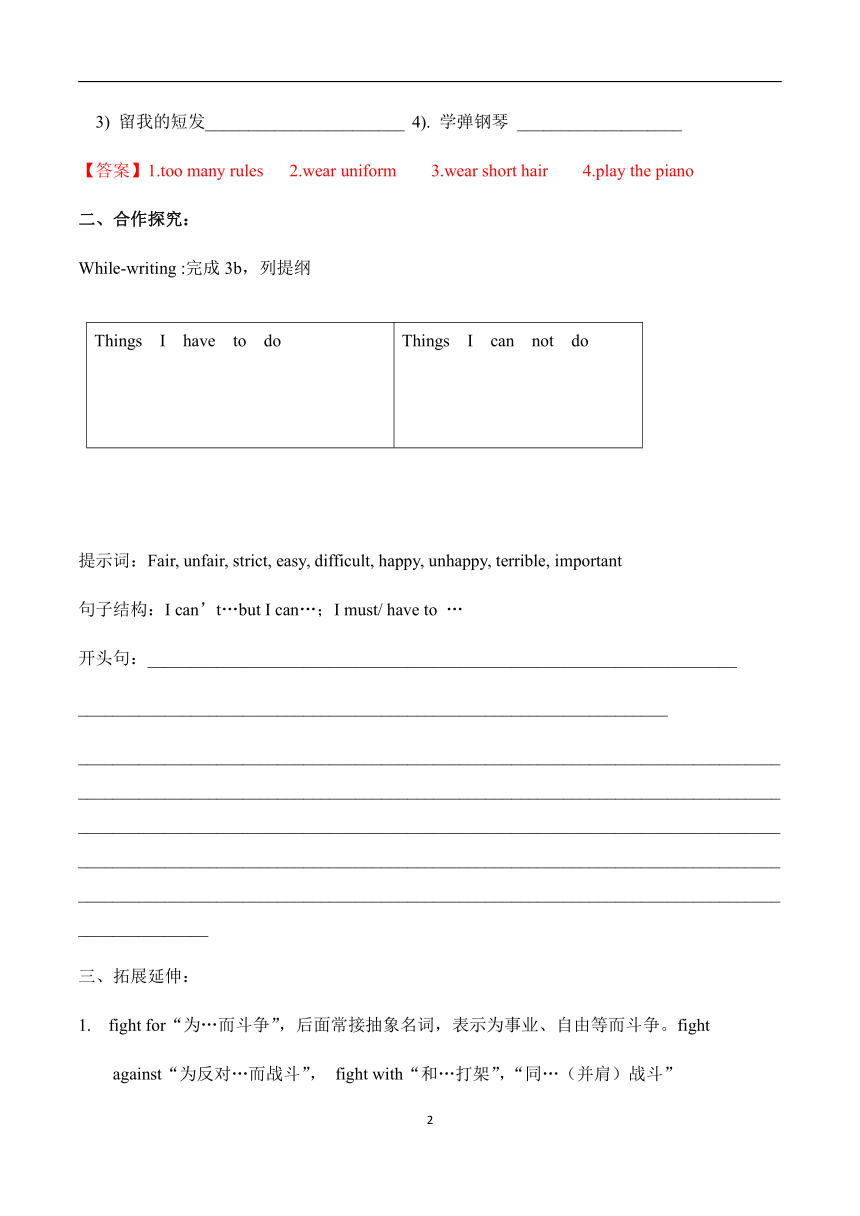Unit 4 Don't eat in class.Section B (3a-self-check)导学案
文档属性
| 名称 | Unit 4 Don't eat in class.Section B (3a-self-check)导学案 |  | |
| 格式 | zip | ||
| 文件大小 | 30.1KB | ||
| 资源类型 | 教案 | ||
| 版本资源 | 人教新目标(Go for it)版 | ||
| 科目 | 英语 | ||
| 更新时间 | 2022-02-24 14:03:26 | ||
图片预览



文档简介
Unit 4 Don’t eat in class.
Section B (3a-selfcheck) 导学案
【学习目标】:
知识与技能:
1、复习谈论规章制度。
2、复习使用 must, have to, can和can’t。
3、练习写自己身边的规章制度。
过程与方法:通过独学和小组合作,学会写规则。
情感态度与价值观:
1. 试着站在家长,老师的角度看待家规,懂得“规则”的必要性。
2. 在遇到压力和烦恼时可以寻找心理医生等健康途径疏导,解决。
【学习重、难点】:
1.重点词汇:relax, strict, feel, remember, follow
2. 重点短语:make one’s bed, be strict (with sb.), follow the rules, too many rules, read a book,
3. 重点语法知识点。
4. 浏览,跳读,信息归纳的阅读技能。
一、自主学习:
1. 完成3a找出文章的开头句和结尾句,将其划线.
2. 朗读文章并翻译下列短语:
1) 太多的规则____________________ 2). 穿校服____________________
3) 留我的短发_______________________ 4). 学弹钢琴 ___________________
【答案】1.too many rules 2.wear uniform 3.wear short hair 4.play the piano
二、合作探究:
While-writing :完成3b,列提纲
Things I have to do Things I can not do
提示词:Fair, unfair, strict, easy, difficult, happy, unhappy, terrible, important
句子结构:I can’t…but I can…;I must/ have to …
开头句:____________________________________________________________________
____________________________________________________________________
____________________________________________________________________________________________________________________________________________________________________________________________________________________________________________________________________________________________________________________________________________________________________________________________________________________________________
三、拓展延伸:
1. fight for“为…而斗争”,后面常接抽象名词,表示为事业、自由等而斗争。fight
against“为反对…而战斗”, fight with“和…打架”,“同…(并肩)战斗”
They fought ________the Italians in the last war, but__ _____them in this war.
with; with B. with; for C. against ; against D. with; against
【答案】D
2.Ms./Mrs./Miss.
Ms.:“女士”,用于婚姻状况不明或不想区分婚否的女子的姓前。Mrs.:“夫
人”,用于已婚女子姓前。Madam:也用于已婚女子,意为“夫人、女士”,一 般
单独使用,不与姓连用
Miss.:“小姐”用于未婚女子姓前,还常用于年轻的女教师的姓前,可译为“老 师”。
3. 辨析: get to/reach/arrive
get to+地点;reach+地点arrive at+小地点(车站等);arrive in+大地点(国家等)
---What time did the team _______the top of the mountain
---At about 4:30 p.m.
come B. go C. arrive D. arrive at
【答案】D
on time“准时,按时”,指按规定的时刻不早不晚。in time“及时”,指没有迟到
hear、listen和sound都有"听"的意思,但三者是有区别的:hear"听说"?侧重于 "听"的内容。listen"听"侧重于"听"这一动作. sound"听起来"?它是系动词后面接形容词等。
________ carefully, or you are not able to________ anything. (be able to do sth能做…)
Hear; listen B. Listen; hear C. Hear; listen D. Listen; listen
【答案】B
6. 辨析take, bring
take“带走,拿走”指把东西从说话地带到别的地方。bring“带来”指把东西
从别处带到说话地。________away this dirty shirt and ________me a clean one.
Take; bring B. Take; take C. Bring; take D. Bring; bring
【答案】A
7. strict是形容词,意为 “严格的”; “严厉的”,通常与be动词连用。
be strict with sb “对某人严厉”be strict in (doing) sth “对某事要求严格”
8. remember“记得,记住”,是及物动词,可以直接加名词。
remember doing sth记得已做某事(已做)remember to do sth 记得要做某事(还没做)forget
help作动词意为“帮助”,常用的结构有:help sb (to) do sth帮助某人做某事
help sb with sth(n.)帮助某人做某事help oneself(myself/yourself/herself…) to+n.请 随便用…
help还可作名词,表示“帮助”,是不可数。
10.too many, too much与much too
易混词组 意义及用法 例句
too many 形容词,“太,太多”,接可数名词 There are too many people in the park.
too much 形容词,“太多”,接不可数名词 I have too much homework today.
much too 副词,“太,非常”,接形容词或副词 My mother is much too busy.
I have ________skirts and this one is ________large for me, so you can take it if you like.
too many; too much B. too much; much too C. too many; much too
【答案】 C
11 . be in bed "在床上、卧床",in 和bed之间不能用冠词,bed也不用复数。
12. No talking ! "禁止交谈。"no后面加上名词或动名词doing也表示不要做某事.
四、随堂检测:
I、精挑细选
( )1. —Can we speak Chinese
— _______.
A. Yes, you can B. OK, you speak C. No, you don’t
( )2. — _________. Your father is sleeping in the room.
— Oh, sorry.
A. Not talk B. Not talking C. No talking
( ) 3. Don’t eat ________class.
at B. in C. to
( ) 4. Gina often helps her mother ________the dishes.
A. do B. does C. doing
( ) 5.—_________you have to wear a hat today — No, we don’t.
A. Are B. Can C. Do
( ) 6. We don’t know Jack _____ Bruce.
A. and B. or C. about
【答案】1.A 2.C 3.B 4.A 5.C 6.B
学后反思
不足:
收获:
1
Section B (3a-selfcheck) 导学案
【学习目标】:
知识与技能:
1、复习谈论规章制度。
2、复习使用 must, have to, can和can’t。
3、练习写自己身边的规章制度。
过程与方法:通过独学和小组合作,学会写规则。
情感态度与价值观:
1. 试着站在家长,老师的角度看待家规,懂得“规则”的必要性。
2. 在遇到压力和烦恼时可以寻找心理医生等健康途径疏导,解决。
【学习重、难点】:
1.重点词汇:relax, strict, feel, remember, follow
2. 重点短语:make one’s bed, be strict (with sb.), follow the rules, too many rules, read a book,
3. 重点语法知识点。
4. 浏览,跳读,信息归纳的阅读技能。
一、自主学习:
1. 完成3a找出文章的开头句和结尾句,将其划线.
2. 朗读文章并翻译下列短语:
1) 太多的规则____________________ 2). 穿校服____________________
3) 留我的短发_______________________ 4). 学弹钢琴 ___________________
【答案】1.too many rules 2.wear uniform 3.wear short hair 4.play the piano
二、合作探究:
While-writing :完成3b,列提纲
Things I have to do Things I can not do
提示词:Fair, unfair, strict, easy, difficult, happy, unhappy, terrible, important
句子结构:I can’t…but I can…;I must/ have to …
开头句:____________________________________________________________________
____________________________________________________________________
____________________________________________________________________________________________________________________________________________________________________________________________________________________________________________________________________________________________________________________________________________________________________________________________________________________________________
三、拓展延伸:
1. fight for“为…而斗争”,后面常接抽象名词,表示为事业、自由等而斗争。fight
against“为反对…而战斗”, fight with“和…打架”,“同…(并肩)战斗”
They fought ________the Italians in the last war, but__ _____them in this war.
with; with B. with; for C. against ; against D. with; against
【答案】D
2.Ms./Mrs./Miss.
Ms.:“女士”,用于婚姻状况不明或不想区分婚否的女子的姓前。Mrs.:“夫
人”,用于已婚女子姓前。Madam:也用于已婚女子,意为“夫人、女士”,一 般
单独使用,不与姓连用
Miss.:“小姐”用于未婚女子姓前,还常用于年轻的女教师的姓前,可译为“老 师”。
3. 辨析: get to/reach/arrive
get to+地点;reach+地点arrive at+小地点(车站等);arrive in+大地点(国家等)
---What time did the team _______the top of the mountain
---At about 4:30 p.m.
come B. go C. arrive D. arrive at
【答案】D
on time“准时,按时”,指按规定的时刻不早不晚。in time“及时”,指没有迟到
hear、listen和sound都有"听"的意思,但三者是有区别的:hear"听说"?侧重于 "听"的内容。listen"听"侧重于"听"这一动作. sound"听起来"?它是系动词后面接形容词等。
________ carefully, or you are not able to________ anything. (be able to do sth能做…)
Hear; listen B. Listen; hear C. Hear; listen D. Listen; listen
【答案】B
6. 辨析take, bring
take“带走,拿走”指把东西从说话地带到别的地方。bring“带来”指把东西
从别处带到说话地。________away this dirty shirt and ________me a clean one.
Take; bring B. Take; take C. Bring; take D. Bring; bring
【答案】A
7. strict是形容词,意为 “严格的”; “严厉的”,通常与be动词连用。
be strict with sb “对某人严厉”be strict in (doing) sth “对某事要求严格”
8. remember“记得,记住”,是及物动词,可以直接加名词。
remember doing sth记得已做某事(已做)remember to do sth 记得要做某事(还没做)forget
help作动词意为“帮助”,常用的结构有:help sb (to) do sth帮助某人做某事
help sb with sth(n.)帮助某人做某事help oneself(myself/yourself/herself…) to+n.请 随便用…
help还可作名词,表示“帮助”,是不可数。
10.too many, too much与much too
易混词组 意义及用法 例句
too many 形容词,“太,太多”,接可数名词 There are too many people in the park.
too much 形容词,“太多”,接不可数名词 I have too much homework today.
much too 副词,“太,非常”,接形容词或副词 My mother is much too busy.
I have ________skirts and this one is ________large for me, so you can take it if you like.
too many; too much B. too much; much too C. too many; much too
【答案】 C
11 . be in bed "在床上、卧床",in 和bed之间不能用冠词,bed也不用复数。
12. No talking ! "禁止交谈。"no后面加上名词或动名词doing也表示不要做某事.
四、随堂检测:
I、精挑细选
( )1. —Can we speak Chinese
— _______.
A. Yes, you can B. OK, you speak C. No, you don’t
( )2. — _________. Your father is sleeping in the room.
— Oh, sorry.
A. Not talk B. Not talking C. No talking
( ) 3. Don’t eat ________class.
at B. in C. to
( ) 4. Gina often helps her mother ________the dishes.
A. do B. does C. doing
( ) 5.—_________you have to wear a hat today — No, we don’t.
A. Are B. Can C. Do
( ) 6. We don’t know Jack _____ Bruce.
A. and B. or C. about
【答案】1.A 2.C 3.B 4.A 5.C 6.B
学后反思
不足:
收获:
1
同课章节目录
- Unit 1 Can you play the guitar?
- Section A
- Section B
- Unit 2 What time do you go to school?
- Section A
- Section B
- Unit 3 How do you get to school?
- Section A
- Section B
- Unit 4 Don't eat in class.
- Section A
- Section B
- Unit 5 Why do you like pandas?
- Section A
- Section B
- Unit 6 I'm watching TV.
- Section A
- Section B
- Review of Units 1-6
- Unit 7 It's raining!
- Section A
- Section B
- Unit 8 Is there a post office near here?
- Section A
- Section B
- Unit 9 What does he look like?
- Section A
- Section B
- Unit 10 I'd like some noodles.
- Section A
- Section B
- Unit 11 How was your school trip?
- Section A
- Section B
- Unit 12 What did you do last weekend?
- Section A
- Section B
